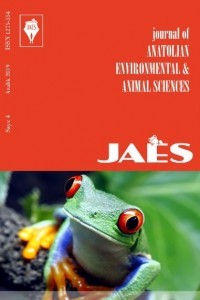Farklı Konsantrasyonlarda Hazırlanmış Tuz Solüsyonlarının Gökkuşağı Alabalığı (Oncorhynchus mykiss) Spermlerinin Dölleme Kabiliyeti Üzerine Etkisi
Aktivasyon solüsyonu, dölleme kabiliyeti, gökkuşağı alabalığı, hareket süresi, sperm
Determination of the Effect of Salt Solutions Prepared in Different Concentrations on Fertilization Ability of Rainbow Trout (Oncorhynchus mykiss) Sperms
Activation solution, fertilization ability, motility duration, rainbow trout, sperm,
___
- Akhan, S., Sonay, F.D. & Yandi, I. (2016). Ağ-kafeslerde kışlatılan gökkuşağı alabalığında (Oncorhynchus mykiss) uzun süreli açlığın bazı verim özellikleri ile vücut kompozisyonu üzerine etkisi. Yunus Araştırma Bülteni, 16, 265-269. Alavi, S.M.H. & Cosson, J. (2005). Sperm motility in fishes. I. Effects of temperature and pH: a review. Cell Biology International 29, 101– 110. Billard, R. (1978). Changes in structure and fertilizing ability of marine and preshwater fish spermatozoa diluted in media of various salinities, Aquaculture, 14(3), 187-198. Billard, R., Cosson, J., Perchec, G. & Linhart, O. (1995). Biology of sperm and artificial reproduction in carp. Aquaculture, 129(1–4), 95-112 Canyurt, M.A., Akhan, S. & Takma, Ç. (2003). Gökkuşağı Alabalığı (Oncorhynchus mykiss Walbaum,1792) spermlerinin kısa süre saklanması üzerine bir araştırma, E.Ü. Su Ürünleri Dergisi, 20, 537-542. Cosson, M.P., Billard, R., Gatti, J. L. & Christen, R. (1985). Rapid and quantitative assessment of trout spermatozoa motility using stroboscopy. Aquaculture 46, 71– 75. Goodall, J.A., Blackshaw, A.W. & Capra, M.F. (1989) Factors affecting the activation and duration of motility of the spermatozoa of the summer whiting (Sillago ciliata), Aquaculture, 77(2–3), 243-250. Khara, H., Noveiri, S.B., Dadras, H., Rahbar, M., Ahmadnejad, M., & Khodadoost, A. (2014). Effect of different activation solutions on motility and fertilizing ability of spermatozoa in common carp Cyprinus carpio Linnaeus, 1758. Indian Journal of Fisheries, 61, 63–68. Krise, W.F., Hendrix, M.A., Bonney, W.A. & Baker‐Gordon, S.E. (1995). Evaluation of sperm‐activating solutions in atlantic salmon Salmo salar fertilization tests. Journal of the World Aquaculture Society, 26, 384-389. Lahnsteiner, F., Weismann, T. & Patzner, R. A. (1998). Determination of the semen quality of the rainbow trout, Oncorhynchus mykiss, by sperm motility, seminal plasma parameters, and spermatozoal metabolism. Aquaculture, 163, 163-181. Morisawa, M. & Suzuki, K. (1980). Osmolality and potassium ion: their roles in initiation of sperm motility in teleosts. Science, 110, 1145-1147. Piironen, J. & Hyvärinen, H. (1983). Composition of the milt of some teleost fishes. Journal of Fish Biology, 22, 351-361. Stoss, J. (1983). Fish Gamete preservation and spermatozoan physiology. In: Hoar, W.S., Randall, D.J. & Donaldson, E.M. (Ed. ) Fish Physiology, Volume 9, Part B, 305-350p, Academic Press, New York-USA. Woolsey, J., Holcomb, M., Cloud, J.G. & Ingermann, R.L. (2006), Sperm motility in the steelhead Oncorhynchus mykiss (Walbaum): influence of the composition of the incubation and activation media. Aquaculture Research, 37, 215-223.
- Yayın Aralığı: Yılda 4 Sayı
- Başlangıç: 2016
- Yayıncı: Bülent VEREP
Gökkuşağı Alabalığı Anaç ve Larvalarda Görülen Gaz Kabarcığı Hastalığı
Muhammed ARABACI, Boran KARATAŞ, Mustafa AKKUŞ
Quratulan AHMED, Sabri BİLGİN, Qadeer Mohammad ALI
Designing New Multifunctional Food Pads Using Red Cabbage Extract (Brassica oleracea)
